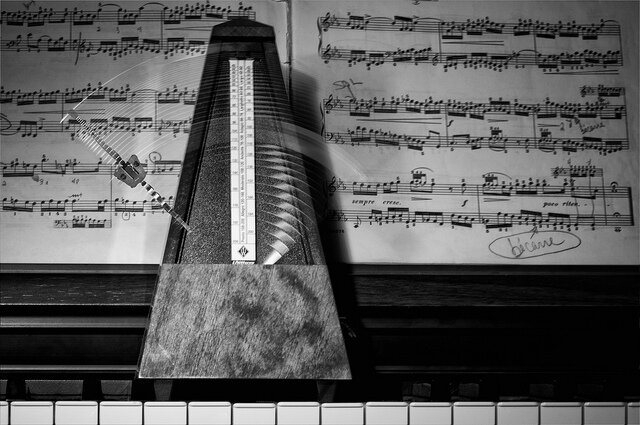
Practicing with a metronome, in my mind, should be one of the most import items on any musician’s ‘to do’ list. For those of you who don’t know, a metronome (also referred to as a click) is an electronic device that gives you a constant click/beat in perfect time. You can adjust the amount of beats per minute ‘bpm’ from a very slow speed (e.g 40bpm) up to a very fast speed (e.g 200bpm).
Practicing with a metronome can improve many areas of your playing. The first thing you’ll find out when you start playing with a metronome is that it will quickly expose how accurately, or not as the case maybe, your timing is. Most people who have only just tried playing with a metronome may find it to be a complete nightmare at first. This is simply because you are not playing in time. How to overcome this will be explained later.
The second reason why it is so important to practice with a metronome, is that it trains you to play in time and also with consistency. Because the click is perfectly in time, if you can manage to play in sync with it, you yourself will be playing perfectly in time. If you can do this regularly enough you’ll find that when you take the metronome away and play without it, your timing will have improved greatly as you will have been training yourself to play in perfect time. This practice needs to be as regular as possible so therefore you’re training as much as possible to be playing in perfect time. Players often find that when their metronome practice starts to slip, their timing also begins to slip.
RELATED How to Find, Transpose and Construct Power Chords
When practicing with the click, try and make your notes as consistent as you can. This means making sure all your notes are played with an equal volume and tone. By doing this not only will the consistency of your notes improve, but your control over the tone and volume of your notes will also improve. This can only be a good thing!
The first thing you should attempt with the metronome is something very simple such as a short scale. Below is the C major scale in TAB. To start with just attempt to play one note per beat at a slow speed such as 80bpm. Whatever you do, don’t attempt to speed up before you are perfectly comfortable with playing the scale at this speed. If you find it hard to start with, try adjusting your metronome to a slightly slower speed such as 75bpm. As you play this through, simply count in your mind; ‘1…2…3…4’ as you play the notes in time with the click.
Next let’s try and play the A pentatonic minor scale along with the click, this time playing two notes per beat. Again, I’d suggest that you keep the metronome set at 75bpm or 80 bpm. As you are now going to play two notes per beat, you will obviously be playing at double the speed. To help you stay in time, try counting; ‘1 and 2 and 3 and 4 and’ as you play through the scale. Take a look at the video to see how this is done. You can try this with any scale/exercise you know, once you have gotten used to playing two notes per beat.
RELATED Easy Songs to Play on Guitar with Simple Chords
Now let’s try and play the same scale, this time playing four notes per beat. This may seem really quick at first, so make sure the metronome is adjusted to a comfortable speed before you start. To begin with set it at 80 bpm but feel free to slow it down until you feel comfortable. If you start too fast, you’ll find it extremely difficult, but once you have slowed it down you’ll find it much easier.
The next logical step is to look at triplets. When playing triplets you are simply playing three notes per beat…hence the word ‘triplets’. This can be pretty awkward to get used to. What you have to think about is the ‘feel’ that playing triplets creates. By playing a scale in triplets, compared to playing it straight, you can make the scale or riff sound completely different. At first make sure you are counting; ‘1…2…3’ in your head as you play along with the click. This should get you on the right track. Once you start to get used to playing three notes per beat, try and listen out for the ‘feel’ of triplets. Start by having a good listen to the video track to get a good idea of what it is you are after. To make life easier for you, the example given is a major scale with three notes on each string. This means that when playing in triplets you start a new string each beat, this should make it easier for you to get your head round the idea of triplets.
image credit – le cabri